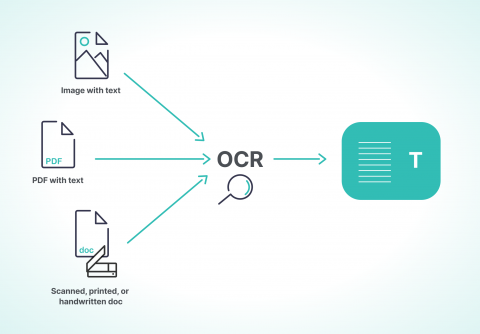Optical Character Recognition (OCR)
OCR is a technology that converts text (i.e., handwritten, printed, typed, or inside images) into a machine-readable, editable, and searchable digital data format. With OCR, optical patterns in digital images are classified based on how they correspond to alphanumeric characters. This means that nearly anything from hard copies of documents and PDFs to JPGs and books can be digitized.

How Optical Character Recognition Works
Despite being a rather straightforward tool, OCR can be difficult to implement. However, understanding how optical character recognition works can help overcome challenges with using it.
Three OCR Content Digitization Steps
The OCR digitization process is conducted in three phases—pre-processing, text or character recognition, and post-processing.
- Pre-processing
To improve the accuracy of the output, OCR software usually pre-processes images. A number of pre-processing techniques are used to:- Clean up non-glyph boxes and lines using line removal.
- Convert any colors or shades of grey to black and white, also referred to as binarization. This makes it easier for the OCR tool to recognize the fonts and separate the text from the background.
- Determine what font is used if the text has non-Latin content.
- Establish a baseline for character and text shapes using line and word detection.
- Identify content formatting, such as columns, paragraphs, and captions, to ensure that it is kept in blocks.
- Refine and improve the characters in the document by smoothing the edges of the letters, taking away any artifacts or imperfections, and removing small imperfections or dust particles (also referred to as de-speckling).
- Scan and align the content as needed so that the text is straight, not tilted.
- Text or character recognition
Optical character recognition works by scanning physical documents and pulling the characters into machine-encoded text. The three techniques that OCR uses to recognize text or characters are pattern recognition, feature detection, or a combination of both.
Pattern Recognition
Pattern recognition identifies characters in their entirety. OCR programs are taught to recognize letters that have been typed using commonly used fonts, such as Times, Arial, Helvetica, Courier, and Calibri), and compare them to existing fonts in a database to find the closest match.
Since most fonts share characteristics, OCR is able to understand text in many fonts. OCR can work with Latin and non-Latin fonts, such as Arabic, Chinese, Cyrillic, Greek, Hebrew, Japanese, Korean, Russian, and Thai.
Feature Detection
Feature detection is a more accurate tool than pattern recognition. Unlike a pattern that detects the individual component features (e.g., angled lines or crossed lines), feature detection looks for features of the character. Using the letter W as an example, pattern recognition would recognize the four lines, whereas feature detection would recognize the pattern, which increases its accuracy.
Pattern Recognition + Feature Detection
In some cases, OCR uses both pattern recognition and feature detection to digitize a document. For instance, OCR programs this combination to digitize handwritten content.
Reducing OCR Errors- Use internal and external dictionaries to cross-reference digitized content.
- Train the OCR program with examples of text in various fonts and formats.
- Use adaptive recognition or a two-pass approach.
- Post-processing
The output from OCR is ASCII (American Standard Code for Information Interchange) code. ASCII is the most common format for digitized text, where each character or number is represented with a 7-bit binary number or simply plain text.
More sophisticated OCR solutions can provide a document or file that looks nearly identical to the original. Either way, after post-processing, OCR content is editable and searchable.
Optical Character Recognition Use Cases
There are many optical character recognition (OCR) use cases. Following are several OCR use cases that exemplify how it is used.
Among the industries that are heavy users of OCR are:
- Banks
- Healthcare organizations
- Human resources and talent management
- Insurance companies
- Law enforcement
- Law firms
- Retail
- Tourism and hospitality
Examples of How OCR Is Used
- Legal firms digitize a wide range of documents, such as handwritten notes, affidavits, filings, judgments, statements, and wills.
- Data entry errors are reduced by eliminating error-prone, manual entries.
- Print material can be digitized and indexed for search engines.
- Documents can be digitized then converted into audio for visually impaired users.
- Deposited checks can be scanned to capture the account information as well as the handwritten information and signature(s).
- Larger organizations use automated mailrooms to categorically sort and forward mail to different groups.
- Invoice automation is used to import hard-copy invoices into accounting systems.
- For eDiscovery, discoverable materials, such as physical contracts, typed letters, JPEGs of photographed documents, and image-only PDFs can be digitized so their content can be searched and cataloged.
- OCR-powered technology also includes translation applications, Google Books, security cameras, and traffic cams that recognize individual vehicles’ license plates.
Optical Character Recognition Benefits
- Allow content to be cut and pasted into any application.
- Convert PDF files, image files, and paper documents into digital files that are easily searchable.
- Convert unstructured content into searchable data.
- Cut down the cost of hiring consultants to help with data extraction.
- Electronically store and manage data in confidential documents.
- Eliminate the need to manually search through cumbersome file cabinets for paper documents.
- Enhance data security by digitizing paper documents that can be more easily accessed, tampered with, and destroyed.
- Minimize time spent processing documents by automating tedious manual processes.
- Move documents to the cloud instead of physical data storage to make them completely accessible to authorized users from any connected device, at any time.
- Provides the ability to edit documents that were in hard copy.
- Reduce the costs associated with on-site and off-site storage of cumbersome paper records.
- Speed recovery after disasters with digital files that can be retrieved faster and more reliably.
Optical Character Recognition Software
Commercial and open-source OCR systems are available for most Latin and non-Latin fonts. These systems are available for on-premise or cloud usage. In addition, OCR engines are available for domain-specific applications, including automating data entry related to invoices, automatic number plate recognition, and airports for passport recognition and information extraction.
A few varieties of optical character recognition software include:
- Intelligent Word Recognition (IWR) captures handwritten texts (cursive or print) with an algorithm that recognizes entire words rather than picking up individual characters.
- Intelligent Character Recognition (ICR) captures handwritten texts (cursive or print) by identifying a single character at a time.
- Optical Mark Recognition (OMR) gathers input data by recognizing marks or patterns rather than characters or words.
Fast Track to Digitize Content Locked on Paper
Massive amounts of valuable information are stored in paper documents. Optical character recognition provides a cost-effective, efficient solution for digitizing that content.
Once in digital format, this content can be used across applications and searched to identify insights. OCR is accessible and applicable to nearly every industry to help extract value from paper-based information.
Egnyte has experts ready to answer your questions. For more than a decade, Egnyte has helped more than 16,000 customers with millions of customers worldwide.
Last Updated: 26th August, 2021



